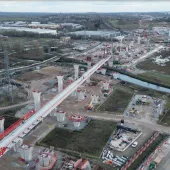Boom for Italy’s concrete construction sector
With Italy's infrastructure investment on the rise, the concrete industry is gearing up for substantial growth opportunities.
Italy's infrastructure landscape is undergoing a significant transformation, driven by an infusion of public and private funds aimed at modernising the country's transportation network. Projections underway, or given the green light indicate a 2.6% increase in infrastructure expenditure from 2021 to 2026, with sustained growth expected at 1.7% annually through 2031 – figures surpassing the Eurozone average.
This surge in infrastructure projects presents a golden opportunity for the concrete industry to contribute significantly to Italy's modernization efforts, according to the organisers of this month's GIC – Italian Concrete Days exhibition (18-20 April 2024, Piacenza, Italy). Speaking ahead of the show,
Fabio Potestà, director of Mediapoint & Exhibitions, and the organizer of GIC, highlighted the pivotal moment for the Italian concrete sector. "With significant investments planned for highways, railways, bridges, tunnels, and viaducts, GIC 2024 will provide a crucial platform for industry players to connect, showcase their latest innovations, and capitalize on this exciting growth potential."A wake-up call for modernisation
The urgency to modernize Italy's infrastructure was underscored by the collapse of the Morandi Bridge in Genoa in 2018. This tragic event brought attention to the aging infrastructure across the country, prompting a re-evaluation of maintenance and development priorities.
Two years later, amid the global pandemic, the opening of the Morandi Bridge’s replacement, the new San Giorgio Bridge, became a symbol of the importance of infrastructure investment not only for public safety but also as a catalyst for economic revival. Politicians clearly heeded this call and have demonstrably prioritised infrastructure development and maintenance, positioning it as a cornerstone of Italy’s national strategy for post-pandemic recovery and future resilience.

Source: Al*from*Lig, CC BY-SA 4.0 via Wikimedia Commons
€27.74 billion EU funding for Italy’s transport infrastructure
The Italian government’s commitment materialised in the form of Italy’s National Recovery and Resilience Plan (NRRP), which was formally approved by the EU in July 2021 and earmarks €23.74 billion in funding from the EU’s Recovery and Resilience Facility (RRF), specifically for the creation of a more modern and sustainable network of roads, railways, ports, and airports.
Significant initiatives include the 364 km Ionian Highway (also known as the SS-106) upgrade project, the 200 km Naples-Bari high-speed railway, Terzo Valico dei Giovi (the 53 km Genoa-Milan high-speed railway), and the 67 km Brenner Base Tunnel (BBT) between Fortezza in Italy and Innsbruck in Austria, which will be the world’s longest underground railway connection upon completion.
With a strict deadline to finalise the RRF financing of projects by the end of 2026, the entire construction supply chain is mobilising to ensure readiness. Furthermore, this positive momentum in the Italian construction equipment and materials markets is expected to continue until 2031, as projects reach their final stages.
Attractive international private investment propositions
At the same time, the Italian infrastructure sector is also attracting significant foreign interest, fuelled by Italy’s strategic position within the Eurozone and the opportunity to address existing critical infrastructure gaps. 71% of international companies, financial institutions, and infrastructure funds surveyed in the 2023 EY Infrastructure Barometer revealed that they have invested or financed Italian infrastructure projects over the past four years, underscoring the immense potential in the Italian market for international companies as well as domestic players.
Given Italy’s vast network of aging bridges, viaducts, and tunnels, where maintenance costs often outweigh the economic viability of repairs, the demolition and recycling of concrete structures will also be a crucial topic at GIC 2024. Both exhibitors and conference speakers will be exploring sustainable solutions for responsible demolition and material recycling, promoting a more circular economy within the construction industry.
For more information about GIC 2024 and to register for a free visitor’s pass, visit www.gic-expo.it.
€27.74 billion EU funding for Italy’s transport infrastructure
The Italian government’s commitment materialised in the form of Italy’s National Recovery and Resilience Plan (NRRP), which was formally approved by the EU in July 2021 and earmarks €23.74 billion in funding from the EU’s Recovery and Resilience Facility (RRF), specifically for the creation of a more modern and sustainable network of roads, railways, ports, and airports.
Significant initiatives include the 364 km Ionian Highway (also known as the SS-106) upgrade project, the 200 km Naples-Bari high-speed railway, Terzo Valico dei Giovi (the 53 km Genoa-Milan high-speed railway), and the 67 km Brenner Base Tunnel (BBT) between Fortezza in Italy and Innsbruck in Austria, which will be the world’s longest underground railway connection upon completion.
With a strict deadline to finalise the RRF financing of projects by the end of 2026, the entire construction supply chain is mobilising to ensure readiness. Furthermore, this positive momentum in the Italian construction equipment and materials markets is expected to continue until 2031, as projects reach their final stages.
Attractive international private investment propositions
At the same time, the Italian infrastructure sector is also attracting significant foreign interest, fuelled by Italy’s strategic position within the Eurozone and the opportunity to address existing critical infrastructure gaps. 71% of international companies, financial institutions, and infrastructure funds surveyed in the 2023 EY Infrastructure Barometer revealed that they have invested or financed Italian infrastructure projects over the past four years, underscoring the immense potential in the Italian market for international companies as well as domestic players.
Given Italy’s vast network of aging bridges, viaducts, and tunnels, where maintenance costs often outweigh the economic viability of repairs, the demolition and recycling of concrete structures will also be a crucial topic at GIC 2024. Both exhibitors and conference speakers will be exploring sustainable solutions for responsible demolition and material recycling, promoting a more circular economy within the construction industry.
For more information about GIC 2024 and to register for a free visitor’s pass, visit www.gic-expo.it.







